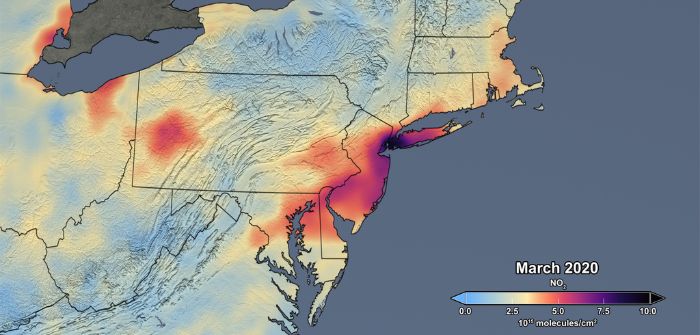NASA is funding research projects to study the effect COVID-19 has had on the planet.
Through the Rapid Response and Novel Research in Earth Science initiative, NASA is funding projects that make innovative use of satellite data and other NASA resources to address environmental, economic and societal impacts of the pandemic.
One project will study the uneven decreases in nitrogen dioxide in urban areas, with satellite data indicating that cities in China and Italy are seeing more abrupt declines than many US cities.
Susan Anenberg, who is conducting the research with Dan Goldberg from The George Washington University, said, “Since air pollution may be a risk factor for increased severity of COVID-19 outcomes, accurate information about air pollution levels during the COVID-19 crisis is critical to protect public health. Our project will also improve public health in the long term by advancing our understanding of how transportation policies can be designed to improve air quality most effectively and efficiently.”
Satellites have observed global decreases in some types of air pollution, but University at Buffalo scientist Kang Sun wants to develop a process to monitor how long the reduction will last and the effect the changes will have on the chemistry of the atmosphere.
Sun said, “Using a new data-driven framework that combines satellite and meteorological data, we will take NASA satellite assets one step further to quantify the reduction in emissions and its impact on air quality chemistry.”
The City University of New York scientists Maria Tzortziou and Brice Grunert will study the impact of air pollution on coastal water quality in Long Island Sound near New York City.
Nitrogen and other chemicals and nutrients in the water can cause excessive algae growth, and when it decomposes, it consumes oxygen.
Tzortziou said, “Socioeconomic policy responses to the COVID-19 pandemic have resulted in a dramatic decline in atmospheric nitrogen pollution across the globe. Yet, the impacts on atmospherically deposited nitrogen and resulting changes in coastal aquatic ecology remain unknown.”
Measures to curb COVID-19 have shifted human activity and movement, and NASA’s Black Marble science team is using satellite night-time light data to access the social and economic impact on a local to global level.
Miguel Román, program director at Universities Space Research Association, said, “Our research team has been analyzing images of Earth at night to decipher patterns of energy use, transportation, migration, and other economic and social activities. Currently, there is minimal data about how different containment strategies have affected local businesses and neighborhoods, and how companies and residents are responding to preventative measures aimed at containment.”



